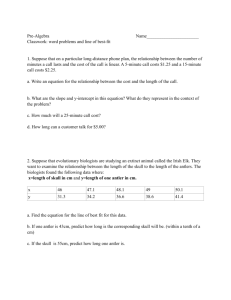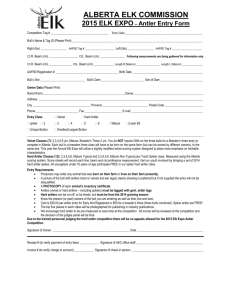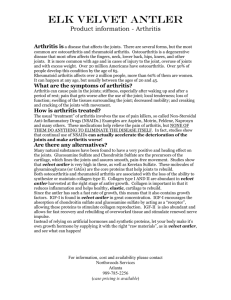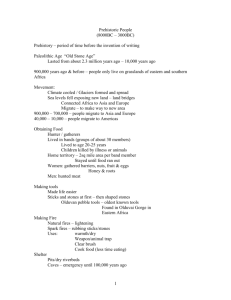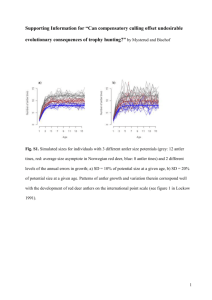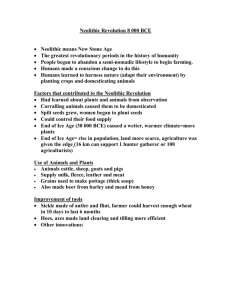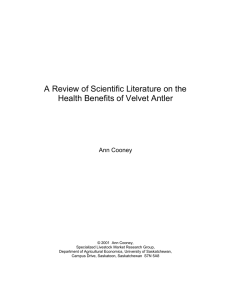Elk Velvet Antler - A Dietary Supplement from Yesterday for Today
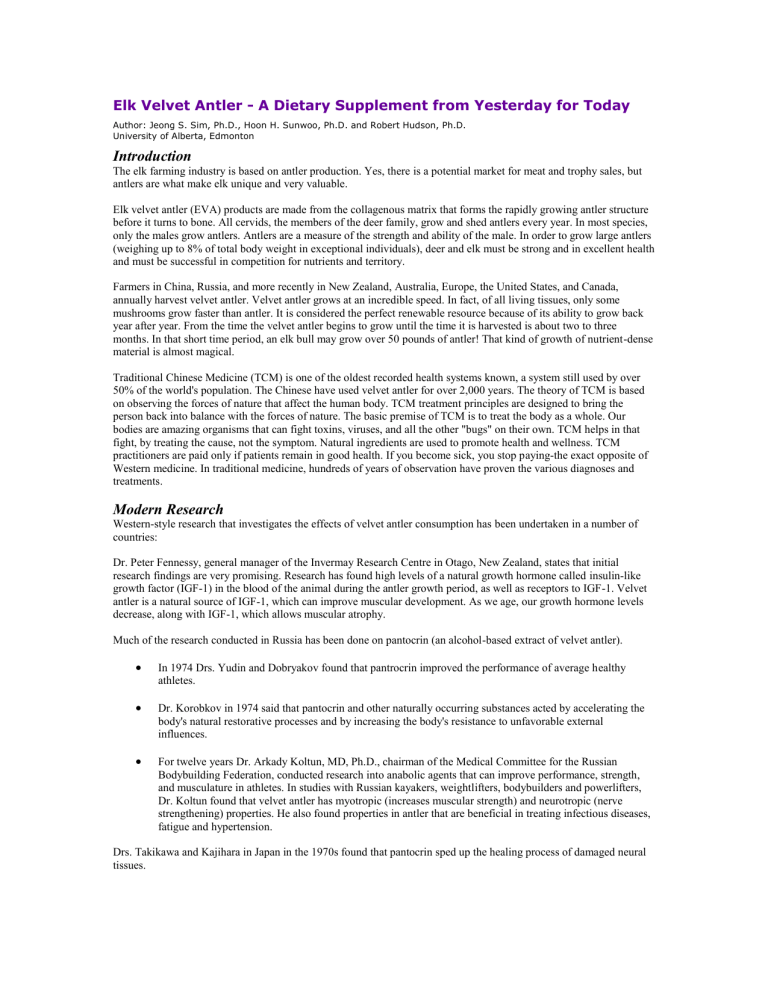
Elk Velvet Antler - A Dietary Supplement from Yesterday for Today
Author: Jeong S. Sim, Ph.D., Hoon H. Sunwoo, Ph.D. and Robert Hudson, Ph.D.
University of Alberta, Edmonton
Introduction
The elk farming industry is based on antler production. Yes, there is a potential market for meat and trophy sales, but antlers are what make elk unique and very valuable.
Elk velvet antler (EVA) products are made from the collagenous matrix that forms the rapidly growing antler structure before it turns to bone. All cervids, the members of the deer family, grow and shed antlers every year. In most species, only the males grow antlers. Antlers are a measure of the strength and ability of the male. In order to grow large antlers
(weighing up to 8% of total body weight in exceptional individuals), deer and elk must be strong and in excellent health and must be successful in competition for nutrients and territory.
Farmers in China, Russia, and more recently in New Zealand, Australia, Europe, the United States, and Canada, annually harvest velvet antler. Velvet antler grows at an incredible speed. In fact, of all living tissues, only some mushrooms grow faster than antler. It is considered the perfect renewable resource because of its ability to grow back year after year. From the time the velvet antler begins to grow until the time it is harvested is about two to three months. In that short time period, an elk bull may grow over 50 pounds of antler! That kind of growth of nutrient-dense material is almost magical.
Traditional Chinese Medicine (TCM) is one of the oldest recorded health systems known, a system still used by over
50% of the world's population. The Chinese have used velvet antler for over 2,000 years. The theory of TCM is based on observing the forces of nature that affect the human body. TCM treatment principles are designed to bring the person back into balance with the forces of nature. The basic premise of TCM is to treat the body as a whole. Our bodies are amazing organisms that can fight toxins, viruses, and all the other "bugs" on their own. TCM helps in that fight, by treating the cause, not the symptom. Natural ingredients are used to promote health and wellness. TCM practitioners are paid only if patients remain in good health. If you become sick, you stop paying-the exact opposite of
Western medicine. In traditional medicine, hundreds of years of observation have proven the various diagnoses and treatments.
Modern Research
Western-style research that investigates the effects of velvet antler consumption has been undertaken in a number of countries:
Dr. Peter Fennessy, general manager of the Invermay Research Centre in Otago, New Zealand, states that initial research findings are very promising. Research has found high levels of a natural growth hormone called insulin-like growth factor (IGF-1) in the blood of the animal during the antler growth period, as well as receptors to IGF-1. Velvet antler is a natural source of IGF-1, which can improve muscular development. As we age, our growth hormone levels decrease, along with IGF-1, which allows muscular atrophy.
Much of the research conducted in Russia has been done on pantocrin (an alcohol-based extract of velvet antler).
In 1974 Drs. Yudin and Dobryakov found that pantrocrin improved the performance of average healthy athletes.
Dr. Korobkov in 1974 said that pantocrin and other naturally occurring substances acted by accelerating the body's natural restorative processes and by increasing the body's resistance to unfavorable external influences.
For twelve years Dr. Arkady Koltun, MD, Ph.D., chairman of the Medical Committee for the Russian
Bodybuilding Federation, conducted research into anabolic agents that can improve performance, strength, and musculature in athletes. In studies with Russian kayakers, weightlifters, bodybuilders and powerlifters,
Dr. Koltun found that velvet antler has myotropic (increases muscular strength) and neurotropic (nerve strengthening) properties. He also found properties in antler that are beneficial in treating infectious diseases, fatigue and hypertension.
Drs. Takikawa and Kajihara in Japan in the 1970s found that pantocrin sped up the healing process of damaged neural tissues.
In Canada, a team working with Dr. Jeong Sim at the University of Alberta has observed a number of interim results from consumption of velvet antler or antler extracts, including:
Enhanced cell and whole animal growth
Anti-stress and anti-inflammatory properties
Increase in HDL (desirable) cholesterol
Increase in red blood cell counts
The Market for Velvet Antler
The velvet antler market is difficult to quantify, largely because customs classifications and agricultural statistics vary from country to country. Korea and Hong Kong are major importers of whole antlers, and they process and re-export sizeable quantities to Europe and North America. Korean imports seem to account for about 85% of the international export market and are currently valued at more than $1 billion. A much larger quantity, possibly as much as ten times as much, is consumed in the producing countries.
New Zealand is a major supplier of antler to the world market. Exports from that country approached 600 tonnes (200 tonnes dried) in 1996. China has greatly expanded its productive capacity to over 400 tonnes fresh weight, but expert opinions seem to vary greatly each year. Russia has produced about 80 tonnes of excellent quality antler in past years, but this has changed with the restructuring of the country. Recently, larger quantities of product of variable quality have been offered to international buyers. Product from Eastern Europe also has increased sharply. North America is still a small player, producing about 100 tonnes in 1997.
With the increasing affluence of all Asian countries, consumption of "luxury" nutraceuticals like velvet antler is expected to increase. Here in North America, we have all witnessed a rise in popularity and confidence in nutraceuticals and natural medicines of all kinds. Velvet antler fits in well with that trend, especially with the long and deep history it brings.
The primary obstacle that our industry faces in accessing the North American market is the lack of solid evidence based on "Western science" to substantiate the knowledge provided by traditional Asian medicine. We have begun, but only just.
The ASPT Symposium
Leading researchers around the world from many different disciplines have begun to look at antler beyond its traditional herbal medicinal uses; however, seldom do they have the opportunity to meet and share their expertise and research findings in these diversified disciplines. Dr. Sim organized and hosted the first International Symposium on
Antler Science and Product Technology (ASPT) in Banff, Alberta, April 9-12, 2000.
This symposium, the first of its kind, was designed to assist in linking the West to the East, connecting producers to consumers and uniting scientists with the business community. The meeting attracted an internationally diverse group of people: business professionals, scientific researchers, public health professionals, processors, farmers and consumers from eight different countries. It was an unqualified success.
The meeting has earned overwhelming support and enthusiasm from the industry and the scientific community. It was a true example of team effort between the university and the industry. The symposium attracted over 300 delegates from
14 different countries. Over 27 invited plenary speakers contributed the highest quality scientific papers and 31 poster presentations in a wide range of antler science and product technology disciplines. A video media release on the symposium, funded by NAEBA and the Alberta Elk Association, is available to associations for use in public relations events. And a book of the proceedings of the benchmark meeting, which contains all of the science presented, will be available very soon.
